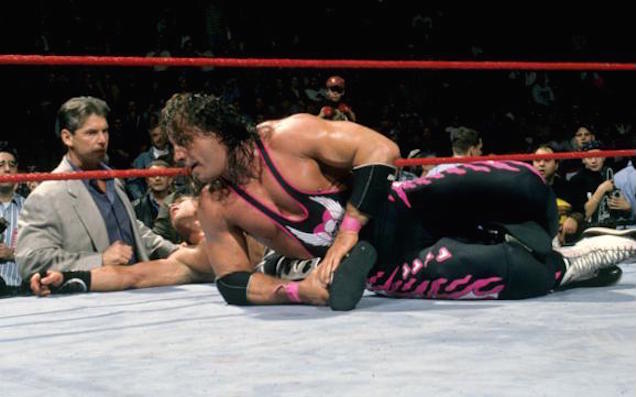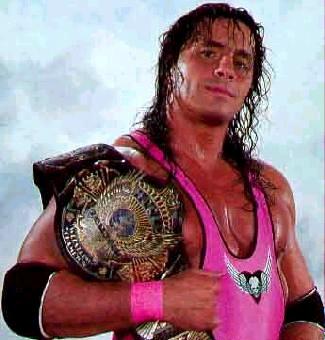The Day Fake Wrestling Became Real
Bret “The Hitman” Hart, pictured above, was a wrestling icon in the late 1980s and well into the 1990s. Born to a pro wrestler, Hart’s DNA and training made him a natural performer in the “squared circle,” to use the parlance of the industry. He signed on with Vince McMahon’s World Wrestling Federation (WWF, but now World Wrestling Entertainment, or WWE) in 1984 and quickly became a star. Hart — branded “the best there is, the best there was, and the best there ever will be” — was beloved by fans, especially those in his native Canada. He won the WWF heavyweight title belt five times and, in many ways, was the face of the WWF for much of the 1990s. To many, he was a hero — one to whom no lasting harm could ever befall. After all, that’s how it was scripted.
Until the day the script changed — and no one told him.
In the mid-1990s the WWF was, for all intents and purposes, the only wrestling franchise that mattered. Seeing a chance to get in on the action, TV mogul Ted Turner decided to start a wrestling company of his own, called World Championship Wrestling or WCW. Turner’s strategy was to buy himself some champions, offering buckets of money to WWF’s wrestlers if they left McMahon-owned company and joined WCW. Many WWF icons took the payday.
In 1996 through 1997, WCW targeted Bret Hart, offering him more than $2.5 million to leave the WWF. Hart waffled between staying with McMahon — his mentor — and making more money than he’d ever think he’d make. Ultimately, the dollars won out, and Hart informed McMahon of his plans to leave for the green. The split was amicable, but there was a logistical problem: Hart was the reigning WWF champion, and leaving for WCW with that designation could harm the WWF franchise. Both he and McMahon agreed that he’d have to lose the title belt before leaving — both men had respect for one another, and for the storyline.
McMahon proposed that Hart face the obvious top contender, a flamboyant wrestler named Shawn Michaels. The title bout would take place in Montreal on November 9, 1997, during a pay-per-view special called the Survivor Series. Under McMahon’s plan, Michaels would beat Hart, claiming the title, and allowing Hart to walk away from the WWF without anything seeming amiss. Hart understood that something would have to go wrong for him to lose the belt, but as Radiolab discussed, he didn’t want to lose to Michaels (whom, even in the unscripted world, he didn’t like), and he certainly did not want to lose a title match in front of his home country’s fans. Instead, Hart proposed that the match break down into a melee, with Michaels’ and Hart’s allies entering the ring uninvited. Hart, under his plan, would be disqualified during the match and forfeit the title later on. McMahon agreed.
The match went roughly as planned — Hart and Michael entered the ring and started throwing punches at one another, somehow ended up outside the ring and into the first rows of the crowd, and then came back into the ring for the first big move of the match. With Michaels in the middle of the ring, seemingly incapacitated, Hart climbed the ropes and flung himself through the air at his opponent. Michaels — and this was scripted — pulled the referee between him and the airborne Hart at the last moment. All three men ended up on the mat, barely moving, setting up the perfect opening for the parade of others and ultimately, the planned-for disqualification.
But that’s not what happened. Michaels popped up and pinned Hart, using Hart’s “trademark” submission move, no less. Michaels didn’t immediately offer Hart a way out of the hold, and Hart didn’t see any reason to break out of the move quickly — this wasn’t how the match was supposed to end — but the ref came to, counted Hart out, and instructed the ringside official to ring the bell. Michaels had won. And Hart had no idea what had just happened

The truth came to him quickly enough, though. Hart looked around, as seen above, and soon saw McMahon (in the beige blazer) standing ringside. The ruse Hart just fell prey to crystallized in his mind. McMahon had panicked, concerned that rumors of Hart’s move to the WCW were spreading too quickly; as a result, McMahon, Michaels, and others had conspired against him to take the title away from him. Hart stood up, spit in McMahon’s face, and then smashed hundreds if not thousands of dollars of technical equipment. And then, for a final coup de grâce, he re-entered the ring and started writing the letters “W-C-W” in the air with his finger, cluing in fans at home and in Montreal about what just occurred. (The event would later become known as “the Montreal Screwjob,” the latter word a piece of wrestling lingo for when a wrestler is double-crossed by an unscripted act.) The TV broadcast ended four minutes early, in part because things got so out of hand.
In this case, though, the story didn’t end when the TV cameras stopped rolling. Hart was being followed by a documentary film crew, so most of what happened backstage also made it to TV. Hart, to his credit, asked the documentary crew to stop filming before he confronted McMahon one final time — and, as Sports Illustrated reported, punched his now ex-boss in the face. As McMahon learned the hard way, scripted wrestling ends when the cameras turn off, but reality has a way of continuing onward.
Bonus Fact: Tragically, for the Hart family, the Montreal Screwjob isn’t the worst incursion of reality into the fantasy that is professional wrestling. In 1999, Bret’s brother, Owen Hart, was a wrestler for the WWF. During another pay-per-view event, Owen was to enter the ring from above, descending from the rafters in a tethered harness. Unfortunately, something went wrong. The tether came undone and Hart fell more than 70 feet, landing on the top rope and then into the ring. Owen Hart did not survive the fall.
From the Archives: Japan’s First NHL Player: A little bit of fiction invades a real sport.
Take the Quiz: Can you name the slang terms used in pro wrestling?
Related: “Hitman: My Real Life in the Cartoon World of Wrestling,” Bret Hart’s autobiography. 4.7 stars on 289 reviews. Also, “Hitman Hart: Wrestling with Shadows,” the above-mentioned documentary. Available for free on YouTube.

